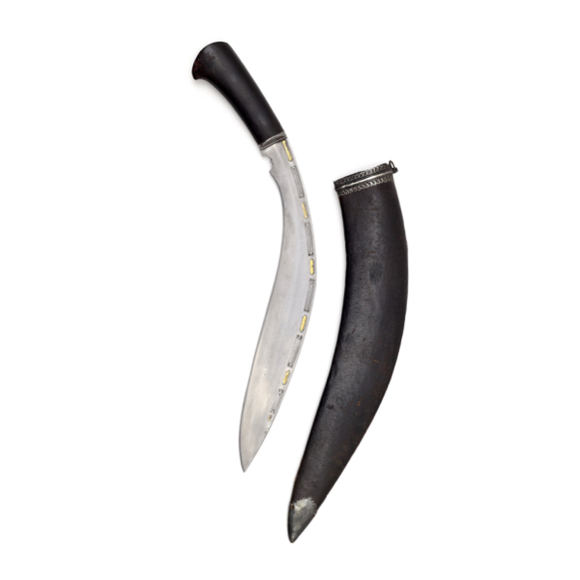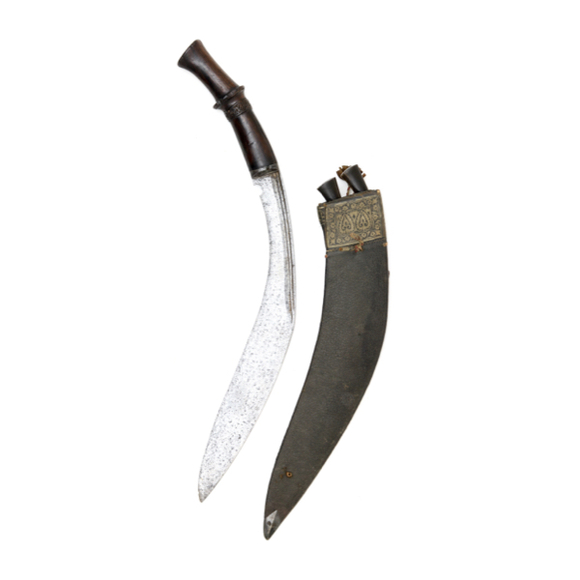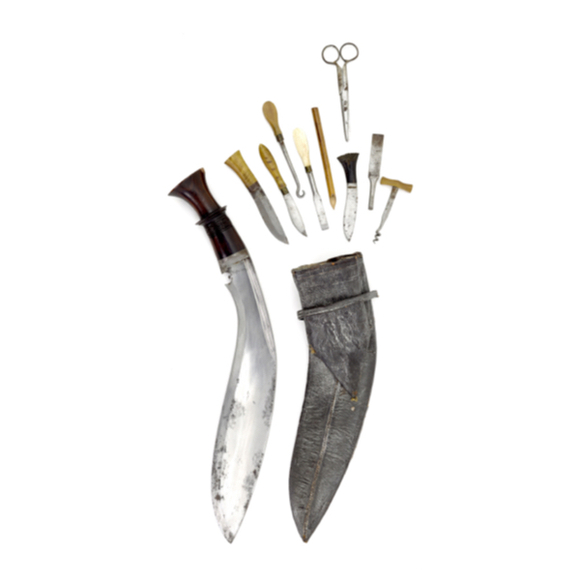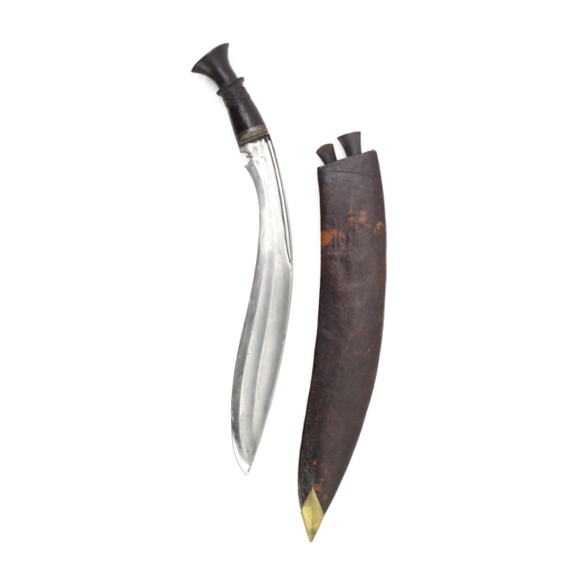Russet iron, one-piece construction with decorative grooves.

Sheathed 83.8 cm
Sword 63.5 cm
47.3 cm
Base 7 mm
Middle 4 mm
Tip 3.5 mm
Base 32 mm
Middle 34 mm
Tip 75 mm
602 grams
16 cm from hilt
Iron, steel, wood, rattan, pigment, lacquer, silver, ivory, bone.
Northern Kachin
"the country of the Khumongs, above latitude 27° 15' and in about longitude 97° 30"
-Errol Grey, 1885
19th century
European antique art market
Introduction
These swords are mainly known as "Kachin dha" or "Naga dha" in reference to the people who wore them, but they were in much wider use, also by the Karen and other groups.
As it turns out, one subtribe of the Jingpo produced and widely traded them. In colonial writings, the weapon is known as “Hkamti dha” or “Linkin dha” the latter after the Burmese word for them: lin gin (လင်းကင်း).
Adventurer and tea planter Errol Gray who traveled extensively through the northern frontier observed such dha being produced in northern Kachin in 1885. Sir James George Scott reports from his interactions with Gray:
"Besides this the only other industry seems to be the manufacture of dhas, and that is confined to the Tarengs, who do not appear to be true Kachins. Mr. Errol Grey, who calls them the best blacksmiths of the Khakhu country, says that they make all the dhas worn by every Kachin and Hkamti Shan adult north of the confluence.
These dhas under the name of Hkamti dhas form one of the chief articles of trade between the Hkamti valley and Assam. The iron is found in the hills forming the boundary between the Tarengs and Khunnongs. It is of excellent quality and the knives are very durable.
Mr. Errol Gray continues:
“These dhas are made in four varieties:
(i) The streaked (or dorica mela as it is called in Assam),
having four lines running longitudinally down the blade.
(a) The spotted dha, having numerous black spots cover-
ing both sides of the blade, as if indented by being
hit by some pointed instrument, but really natural.
(3) The white dha, with a perfectly clear blade, without
spot or line.
(4) The black dha, a dirty, rough-looking blade, giving the
idea that the process of manufacture is not complete.
These weapons are about eighteen inches long in the blade, and are broader at the point than at the handle. They are ground to have an edge in the form of that of the chisel. With the handle a couple of such dhas weigh a little over two pounds.
The streaked dha is invariably worn by the nobility and gentry of the Hkamti country.” 1
For more information, see my glossary article: Lin gin (လင်းကင်း).
Notes to introduction
1. Sir James George Scott, assisted by John Percy Hardiman; Gazetteer of Upper Burma and the Shan States, Part I Volume I. Superintendent, Government Printing Burma, 1900. Page 438.
This example
A rare “streaked dha” as described by Errol Grey above, which he said was worn exclusively by local nobility.
It features a blade with the “hairpin forging”, accomplished by forging rods of iron and steel together and then folding it once, stacking the rods over the width of the blade. Such a construction is also seen on swords from Tibet, Sikkim and Bhutan.
All parts are higher quality, with a red lacquered wooden hilt with a silver ferrule, now tarnished a dark blueish grey. The T-shaped pommel section is capped with an ivory backplate.
It comes in a red painted wooden half scabbard, with braided rattan. Most of the rattan baldric is now lost. It also retains a leopard-jaw talisman that was often carried with these.
Comparable examples
A simpler example, the so-called "white dha" variety, was in the collection of George Cameron Stone. Now in the Metropolitan Museum in New York.
 A linkin dha in the Metropolitan Museum, New York. Accession number: 36.25.1630a, b
A linkin dha in the Metropolitan Museum, New York. Accession number: 36.25.1630a, b
Provenance: Bequest of George Cameron Stone, 1935.
A photo of two Kachins, one carrying an identical sword was published by Lt. Col. Willoughby Wallace Hooper in 1886.1

"Kaychins, a tribe inhabiting the hilly country to the east of Bhamo."
Photo by by Lt. Col. Willoughby Wallace Hooper, taken 1886.
The Census of India of 1931 shows a number of Nung men carrying this type of dha. The 2nd from the left carries a very similar dha as ours with its characteristic T-shaped pommel.2
"Young Nungs from Upper Nmai Valley"
Published in: Census of India, Volume XI, Burma Part 1. 1931.
Notes to comparable examples
1. Lt. Col. Willoughby Wallace Hooper; "Burmah: a series of one hundred photographs illustrating incidents connected with the British Expeditionary Force to that country, from the embarkation at Madras, 1st Nov, 1885, to the capture of King Theebaw, with many views of Mandalay and surrounding country, native life and industries. London: J. A. Lugard, Bangalore: C. G. Brown, Calcutta: Thacker, Spink and Co. 1887. (Online version.)
2. J.J. Bennison; Census of India 93 Volume XI, Burma Part 1.
Condition
Parts of the rattan baldric missing, some rattan braiding snapped. Some ink stains. A longitudinal crack in the scabbard wood, common on the type. Sword itself in great shape and retains its original finish and natural patina.
CITES
This item contains an ivory plate of the species elephas maximus, and a partial jawbone with teeth of panthera pardus delacouri both listed on CITES appendix I.
The item is within article 2 of council regulation EC NO338/97 and within Convention of International Trade of Endangered Species (CITES): The materials were removed from the wild and significantly altered from their natural state well before the date of the convention: June 1st, 1947. It comes with an independent appraisal certificate confirming the above. It can be freely traded within the EU without a permit and is eligible for a CITES export permit for trade outside of the EU, although in practice these export permits are rarely granted.
Buyers outside of Europe: Beware that it may not be possible to export the item to your country due to restrictions on the international ivory trade. CITES sets the minimal restrictions, countries, and states under the convention often maintain further restrictions on top of CITES.












With a very fine Nepalese blade, but kard-like hilt and scabbard.
Early type with very shallow notch in the blade and little flare in the pommel.
20th century military khukurī with many different tools in its back pocket.






